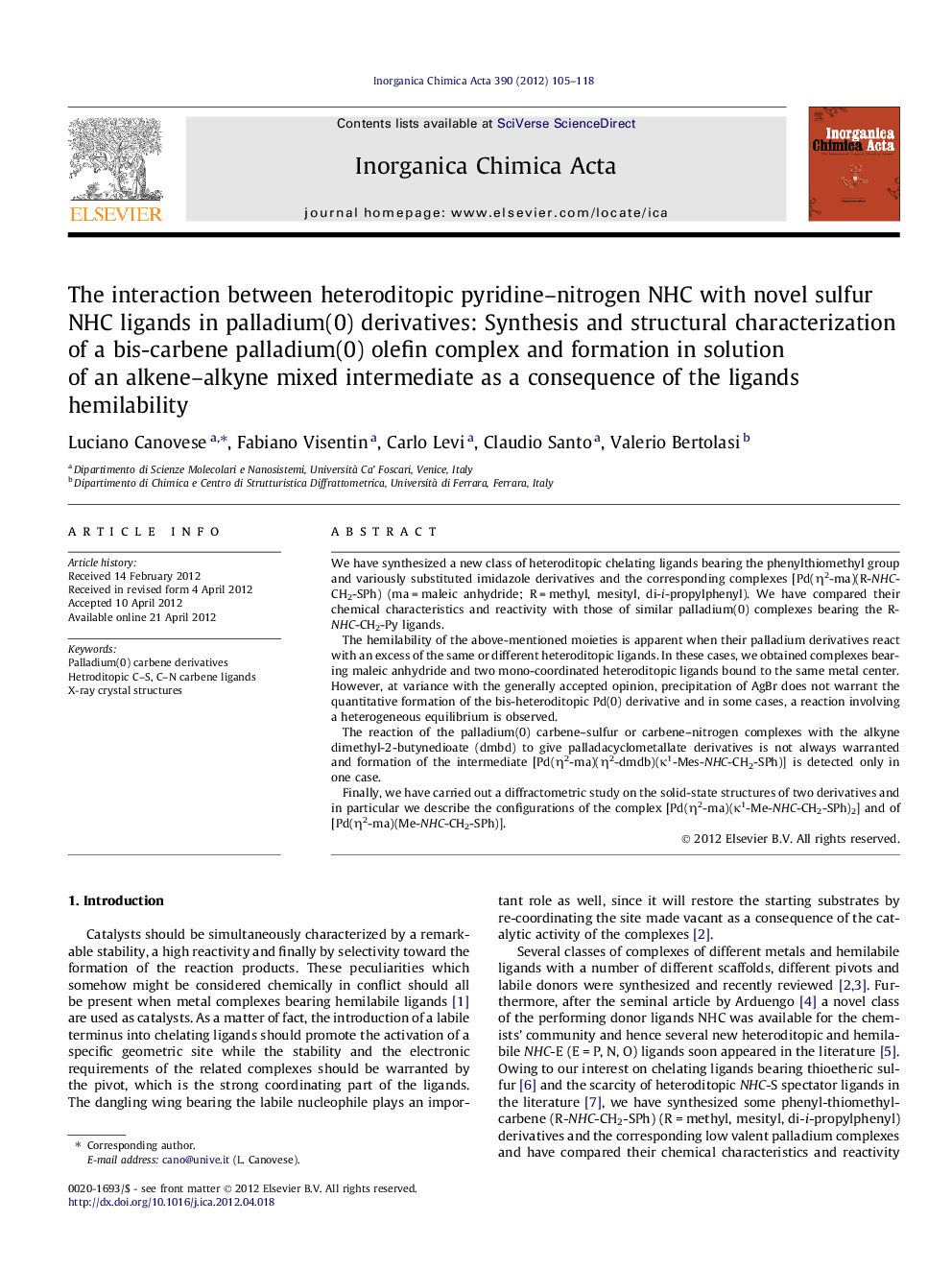| کد مقاله | کد نشریه | سال انتشار | مقاله انگلیسی | نسخه تمام متن |
|---|---|---|---|---|
| 1312438 | 1499197 | 2012 | 14 صفحه PDF | دانلود رایگان |

We have synthesized a new class of heteroditopic chelating ligands bearing the phenylthiomethyl group and variously substituted imidazole derivatives and the corresponding complexes [Pd(η2-ma)(R-NHC-CH2-SPh) (ma = maleic anhydride; R = methyl, mesityl, di-i-propylphenyl). We have compared their chemical characteristics and reactivity with those of similar palladium(0) complexes bearing the R-NHC-CH2-Py ligands.The hemilability of the above-mentioned moieties is apparent when their palladium derivatives react with an excess of the same or different heteroditopic ligands. In these cases, we obtained complexes bearing maleic anhydride and two mono-coordinated heteroditopic ligands bound to the same metal center. However, at variance with the generally accepted opinion, precipitation of AgBr does not warrant the quantitative formation of the bis-heteroditopic Pd(0) derivative and in some cases, a reaction involving a heterogeneous equilibrium is observed.The reaction of the palladium(0) carbene–sulfur or carbene–nitrogen complexes with the alkyne dimethyl-2-butynedioate (dmbd) to give palladacyclometallate derivatives is not always warranted and formation of the intermediate [Pd(η2-ma)(η2-dmdb)(κ1-Mes-NHC-CH2-SPh)] is detected only in one case.Finally, we have carried out a diffractometric study on the solid-state structures of two derivatives and in particular we describe the configurations of the complex [Pd(η2-ma)(κ1-Me-NHC-CH2-SPh)2] and of [Pd(η2-ma)(Me-NHC-CH2-SPh)].
A new class of heteroditopic chelating ligands bearing the phenylthiomethyl group and variously substituted imidazole derivatives and the corresponding complexes [Pd(η2-ma)(R-NHC-CH2-SPh)] (ma = maleic anhydride; R = methyl, mesityl, di-i-propylphenyl) were synthesized and characterized.The reactivity of [Pd(η2-ma)(R-NHC-CH2-SPh)] was compared with that of the carbene–methylpyridine complexes [Pd(η2-ma)(R-NHC-CH2-Py)]. Derivatives bearing maleic anhydride and two mono-coordinated ligands bound to the same metal center were obtained and the solid state structure of the complex [Pd(η2-ma)(κ1-Me-NHC-CH2-SPh)2] was determined.The palladium(0) carbene–sulfur or carbene–nitrogen complexes react with the alkyne dimethyl-2-butynedioate and in one case the formation of the intermediate [Pd(η2-ma)(η2-dmdb)(κ1-Mes-NHC-CH2-SPh)] was detected in solution.Figure optionsDownload as PowerPoint slideHighlights
► Complexes of the type [Pd(η2-ma)(R-NHC-CH2-SPh)] and [Pd(η2-ma)(R-NHC-CH2-Py)] were synthesized and characterized.
► The synthesis of the complex [Pd(η2-ma)(MesNHC-CH2-Py)(MesNHC-CH2-SPh)] is reported.
► Diffractometric investigations on two palladium carbene derivatives are included.
Journal: Inorganica Chimica Acta - Volume 390, 15 July 2012, Pages 105–118